Welding is one of the most common repair processes found in any manufacturing facility. When a metal piece of machinery breaks, welding can be a cheap, fast solution to getting things running again. But as common as it is, there are many methods to welding and each has their own pros and cons. Those that know how to weld are taught one method and generally stick tothat for most of their repairs because it is what they are comfortable with. Here we will go over three methods for welding and the benefits and drawbacks to each.
Mig Welding
Mig welding involves a welder that feeds a wire of material through an electrode which arcs when contacting the metal being welded. As contact is made the electrode and metal heats up joining the two materials together. During this process a shielding gas is also supplied to the weld to prevent gases in the surrounding atmosphere from interfering with the weld. Migwelding is perhaps the most common style used today.
Pros
Cons
Tig Welding
Tig Welding or Tungstun Arc Welding, is a type of welding that uses a rod of tungsten as an electrode that heats up the base material creating a puddle of molten metal used to join pieces together. It is known for being a very clean and very strong welding method.
Pros
Cons
Stick Welding
In this method of welding a flux coated welding rod or “stick” is used as an electrode to carry current and produce an arc once the tip touches the base metal. This material melts with the electrode to create the weld.
Pros
Cons
There you have it, some basic tips on three common welding repair methods. But if you need help with any repair situation be sure to visit us online at www.gesrepair.com or call us at 1-877-249-1701 to learn more about our services. We’re proud to offer Surplus, Complete Repair and Maintenance on all types of Industrial Electronics, Servo Motors, AC and DC Motors, Hydraulics and Pneumatics. Please subscribe to our YouTube page and Like Us on Facebook! Thank you!
